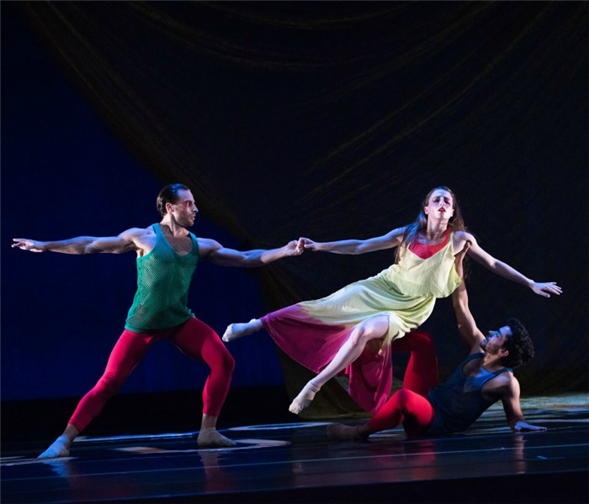Translate Page

How contemporary dance company BODYTRAFFIC highlights emotion in its work
---
For decades, Los Angeles was practically bereft of concert dance. Classically inclined performers worried that moving to the City of Angels would end their careers unless they wanted to take a stab at industrial gigs or Hollywood. But now L.A'.s thriving dance scene proves that a lot can change relatively quickly. One company leading the city's dance evolution is edgy contemporary troupe BODYTRAFFIC, which comes to NYC this month as part of the Joyce Dance: Winter 2017 Series.
While BODYTRAFFIC showcases complex choreography through diverse repertoire, co-artistic directors Tina Finkelman Berkett and Lillian Rose Barbeito say the company started simply as two dancers' means to an end. "I often say 'BODYTRAFFIC was the dream I didn't know I had,'" says Finkelman Berkett. "I just had my sights set on L.A. as a home base. When Lillian approached me, we didn't have some big dream of having 'the world's finest dance company.' We simply felt an obligation to ourselves, the community, and our dancers to offer a high-quality product and bring in our bucket-list choreographers."
The troupe's current program is rich and varied, both intellectually and emotionally engaging. "We want the audience to go on an adventure," says Barbeito. "We love for there to be something conceptual to ponder, as well as that entertainment factor and a tug at the audience's heartstrings. Maybe it's not in that order, but you have a full experience, like fine dining with an appetizer, main course, and dessert.”
Choreographer Anton Lachky's intense Protected: Private Games: Chapter One serves as the entree that pushes both the BODYTRAFFIC dancers and the audience -- the former in stamina and artistic breadth, the latter in remaining calm while watching the fury and fantastical expanse of movement onstage. "When the performers hear the music start, there's this sense of having to run a marathon," Barbeito says. "They're not entirely sure they can make it through. It provokes a lot of fear and excitement. But as any dancer knows, that's an addictive challenge. You can accomplish it if you're in the right head space. Now the dancers know better how to pace themselves through the full-throttle experience."
Lachy himself demanded that same nonstop energy from the outset of rehearsals. "Anton has a clear vision and strong opinions, but he's adamant about not doing any prep work beforehand since he likes to see the dancers improvising," says Finkelman Berkett. "Leading up to rehearsal he warned me that the dancers needed to be in shape in order to handle the nonstop nature of his work." Initially, Lachy even asked the dancers to train only in his method during the piece's development, sacrificing outside activities like ballet and yoga. Watching the performers suffer under the constraints, the co-directors convinced him to allow the dancers' their "extracurriculars." "That was a first for him!" Finkelman Berkett admits.
Richard Siegal's 3 Preludes then serves as a counterpoint to Lachy's fervor-filled piece. The only choreographer who has been tapped by BODYTRAFFIC more than once (three times to be exact), Seigal has created a whimsical palate cleanser, highlighting his talent for sophisticated footwork and fluid musicality. "The audience will be surprised by the contrast," says Barbeito. "We call one section of Anton's piece 'Monster:' It's bizarre and creature-esque. The audience will be in shock hopefully, so then to come out and do something classical -- they might be surprised to see line, simplicity, and easy-to-digest entertainment after something so challenging. Richard's process, in contrast to Anton's, is short and sweet. He improvises with the music while the dancers learn behind him. Once he feels comfortable, they finesse it."
For the final course, Arthur Pita's Death Defying Dances aims to strike a balance between the substantive and the sweet. A tribute to "Queen of the Beatniks" Judy Henske, it finds depth in its subject but also levity in its vibrant theatricality. Henske, now 80, traveled from her home in Pasadena to speak with the dancers as they created the piece in L.A., and Pita helped the young performers understand the zeitgeist and music of the era. Dramatic touches like constantly changing costumes, live animals, and a yellow lace floor complement the surreal narrative.
While the three pieces were chosen to act as foils for one another, they all encapsulate BODYTRAFFIC's signature style: daring, masterful movement paired with unabashed emotion. "There's a trend in contemporary dance to [avoid] emotion," says Barbeito. "While I think it's fine if there's a more abstract work to give the audience a break, we love to show humanity. So we're set on having dancers that are very expressive and pieces that provoke their feelings."
Most of all, Finkelman Berkett and Barbeito want audiences to think of BODYTRAFFIC as the go-to company for distinctive, current pieces that are polished and preserved by the performers. "We want choreographers where you see a work and say, 'That's Kyle' or 'That's Hofesh,'" says Finkelman Berkett. "That's at the top of our priority list, right next to figuring out what work we want to dance and what will allow our dancers to go the farthest. As we stretch into 10 years of work, we want audiences who have seen us before to come and say, ‘Whoa! That's even more 'BODYTRAFFIC-y' than it was last time.'"
---
Lauren Kay regularly covers dance for TDF Stages.
Images: Arthur Pita's Death Defying Dances for BODYTRAFFIC, photos by Joshua Sugiyama
TDF Members: Go here to browse our latest discounts for dance, theatre, and concerts.